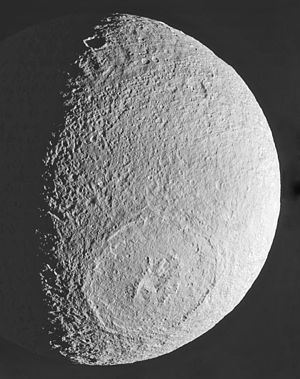Odysseus (crater)
| Tethyscrater Odysseus | |
|---|---|
|
Saturn's moon Tethys with Odysseus crater (below), captured by the Cassini space probe |
|
| properties | |
| width | 32.82 ° N |
| length | 128.89 ° W |
| diameter | 445 km |
| Namesake | Odysseus , hero of the Odyssey |
Odysseus is by far the largest impact crater on Saturn's moon Tethys .
Its naming after Odysseus , the hero of the Odyssey from Greek mythology, was officially confirmed by the IAU in 1982 .
description
Its diameter is 445 kilometers, which is a good 40% or around two fifths of the diameter of Tethys. The fact that the ice moon was not shattered by this impact suggests that it was not completely solid or even liquid at the time. The crater flattened out after its formation and adjusted to the spherical shape of the moon.
In its interior rise the central mountains Scheria Montes. They were named after Scheria in 2008 , the last stop on Odysseus' odyssey and journey home. The mountains extend up to a length of 185 kilometers. The large number of small craters within the large crater shows its great age.
Odysseus lies within the northern hemisphere on the side facing away from Saturn and in the western hemisphere leading to the orbit.
Web links
Individual evidence
- ^ Tethys: Crater, craters. In the Gazetteer of Planetary Nomenclature of the IAU (WGPSN) / USGS . Retrieved June 13, 2017.
- ↑ Bill Arnett: Tethys. In: The Nine Planets.
- ↑ Tethyskarte in the Gazetteer of Planetary Nomenclature of the IAU (WGPSN) / USGS . (PDF)
- ↑ Scheria Montes in the Gazetteer of Planetary Nomenclature of the IAU (WGPSN) / USGS
- ↑ The Odysseus Crater on Tethys - Astronomy Picture of the Day of August 17, 2020.
